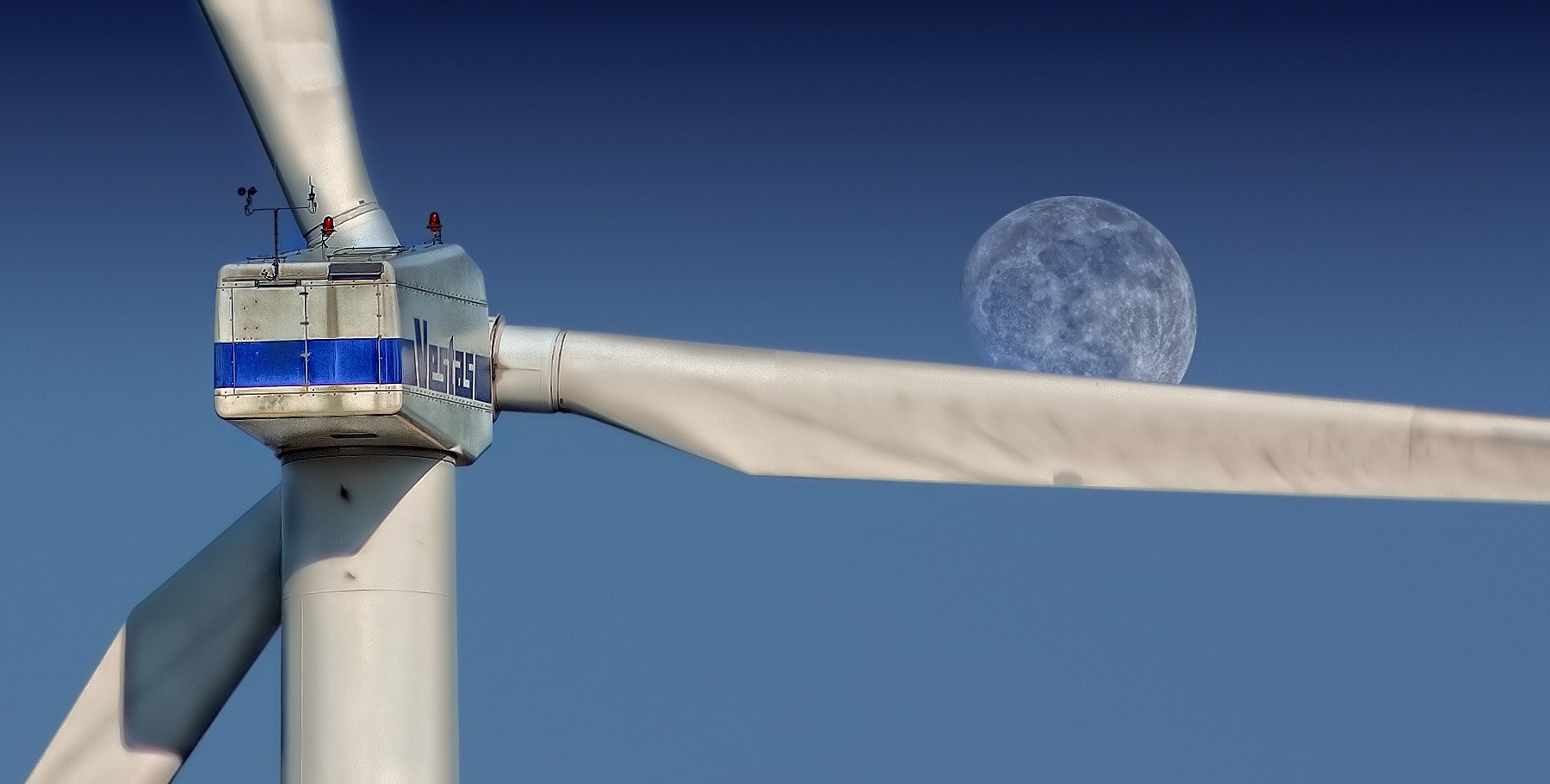By Brenden Cline, Editor-in-Chief, Harvard Environmental Law Review
This post is part of the Environmental Law Review Syndicate. Read the original here and leave a comment.
[This] is a ‘rare case.’ It is and should be . . . . But every generation or so a case comes along when this Court needs to say enough is enough.
— Chief Justice Roberts[1]
As my law school graduation nears, I’d like to advance a common-sense argument for the Clean Power Plan’s statutory authority that only a law student could make: the D.C. Circuit and Supreme Court should reject EPA’s and challengers’ strained readings of the duplicative amendments to Clean Air Act section 111(d) and instead follow the late Justice Scalia’s “irreconcilability canon” to give these amendments no effect. To date, just one brief filed in the torrent of Clean Power Plan litigation mentions the irreconcilability canon in passing.[2] I think this interpretive tool warrants more attention.
So quit the jiggery-pokery, put down the applesauce, and take your head out of a bag. Justice Scalia may no longer be with us, but his immortal words endure.
Background
EPA issued the Clean Power Plan last October to cut greenhouse gas emissions from the nation’s aging fleet of coal-fired power plants. President Obama relied on these projected emissions reductions in negotiating December’s landmark Paris Agreement on climate change. Needless to say, the Clean Power Plan is a big deal.
EPA grounds its authority for this monumental regulation in section 111(d) of the Clean Air Act. Before the 1990 Clean Air Act Amendments, that provision required EPA to regulate “any air pollutant”—subject to a few irrelevant limitations—“which is not included on a list published under section . . . [112](b)(1)(A).”[3] Greenhouse gases are not listed under section 112 (the hazardous air pollutant program), so the original provision would have authorized the Clean Power Plan.
But section 111(d) was amended with a once-in-a-lifetime drafting error. The 101st Congress spent its full term developing the 1990 Clean Air Act Amendments, leaving no time for the House Office of Legislative Council to use its primitive computer software to check the bill for overlapping amendments.[4] As a result, the 1990 Amendments were signed into law with “numerous errors, internal inconsistencies, and bad cross-references,”[5] including two different updates to section 111(d).
One amendment, originating in the House bill, commands:
strik[e] “or 112(b)(1)(A)” and insert[] “or emitted from a source category which is regulated under section 112.”[6]
The other amendment, originating in the Senate bill, says:
strik[e] “112(b)(1)(A)” and insert[] in lieu thereof “112(b).”[7]
On its own, the unclear House amendment could be read to block the Clean Power Plan entirely since coal-fired power plants are source categories regulated under section 112.[8] The Senate amendment, on the other hand, plainly preserves the status quo and authorizes the Clean Power Plan. These Schrödinger’s amendments are “the stuff of a bizarre law school exam.”[9] Unfortunately, the fate of the international climate change agreement may hang on this twenty-six-year-old typo.
EPA makes a strong case for interpreting the two amendments “harmoniously” so that both provisions have the same meaning in context and support the Clean Power Plan.[10] Petitioners argue that the House amendment controls and prohibits “double regulation” of sources under sections 111(d) and 112, forbidding the Clean Power Plan. In the alternative, they insist that the amendments should be added to exclude both air pollutants listed under 112(b) and all pollutants “emitted from a source category which is regulated under section 112.” I have argued elsewhere that petitioners’ interpretations are disingenuous because the section 112(d)(7) savings clause explicitly requires such “double regulation,” and adding these two amendments would make the section 111(d) exceptions swallow the rule.[11] Here, I contend that the D.C. Circuit and Supreme Court should follow another path to interpreting section 111(d).[12]
Ready the Canons
In 2012, Justice Scalia and Bryan Garner collected fifty-seven principles of statutory construction in Reading Law: The Interpretation of Legal Texts. Since then, Chief Justice Roberts[13] and Justices Kennedy,[14] Alito,[15] Sotomayor,[16] and Kagan[17] have cited this treatise in their opinions.
Several of these canons of construction support EPA’s reading of section 111(d). For example, the “harmonious-reading canon” says “[t]he provisions of a text should be interpreted in a way that renders them compatible, not contradictory.”[18] The “presumption against ineffectiveness” holds that “[a] textually permissible interpretation that furthers rather than obstructs the document’s purpose should be favored.”[19] The “whole-text canon” declares that “[t]he text must be construed as a whole.”[20] And the “presumption against implied repeal” says that repeals by implication are “very much disfavored.”[21]
A few canons favor the challengers. The “omitted-case canon” asserts that “[n]othing is to be added to what the text states or reasonably implies,”[22] challenging EPA’s reading of the House amendment. Also, the “harmonious-reading canon” could conceivably be used to add the two amendments together.
Overall, however, petitioners and their amici rely on nontextual interpretive methods. They focus on a congressional record purportedly showing Senate Managers intending to “recede” to the House amendment before mistakenly enacting both amendments, running headlong into Scalia and Garner’s “supremacy-of-text principle.”[23] Moreover, this reliance on legislative history violates the “constitutional requirements of nondelegability, bicameralism, presidential participation, and the supremacy of judicial interpretation.”[24] Led by West Virginia, petitioners also ignore the “desuetude canon” in asserting that EPA’s infrequent use of section 111(d) robs it of power. Ironically, Scalia and Garner point out: “Only West Virginia cases hold that desuetude invalidates.”[25]
Drop It like It’s Hot
Reading Law also identifies a canon that seems to be custom-tailored to the section 111(d) glitch. The “irreconcilability canon” says: “[i]f a text contains truly irreconcilable provisions at the same level of generality, and they have been simultaneously adopted, neither provision should be given effect.”[26] “When reconciliation of conflicting provisions cannot reasonably be achieved, the proper resolution is to apply the unintelligibility canon . . . and to deny effect to both provisions. After all, if we cannot “make a valid choice between two differing interpretations, . . . we are left with the consequence that a text means nothing in particular at all.”[27] Various authorities have recognized this principle,[28] but “[c]ourts rarely reach this result.”[29]
The section 111(d) drafting error is the rare type of problem that this irreconcilability canon could fairly resolve. As the official legislative history to the 1990 Amendments recognizes: “The amendments . . . appear to be duplicative; both, in different language, change the reference to section 112.”[30] Here, “strike A and insert B” and “strike A and insert C” are obviously at odds, regardless of whether B and C can be read to mean the same thing (as EPA argues) or added (as petitioners argue). Before we can reach the question of harmonizing B and C, we must strike A twice. Since A cannot be deleted more than once, only B or C can subsequently be added. (Imagine the superposition that would result otherwise: “any air pollutant . . . which is not included on a list published under section . . . 1[or emitted]1[from a]2[source category]([which is]b[regulated under])[section 112].”) If the former provision is executed first then we get B; if the latter, we get C. But Scalia and Garner rightly dismiss claims that simultaneously enacted earlier-appearing or later-appearing provisions should prevail because “neither of those positions bears any relationship in the usual case to the text’s probable meaning.”[31] Instead, the solution is that “neither provision should be given effect.”[32]
In my view, the irreconcilability canon empowers the D.C. Circuit and Supreme Court to candidly recognize that the House-Senate conference committee did not reconcile these duplicative amendments the way it should have. What’s more, invoking this canon fosters positive spillover effects. Scalia and Garner write that “restor[ing] sound interpretive conventions. . . . will discourage legislative free-riding, whereby legal drafters idly assume that judges will save them from their blunders.”[33] After all, “[t]he canons influence not just how courts approach texts but also the techniques that legal drafters follow in preparing those texts.”[34] Further, adopting this interpretive principle would respect the Constitution’s separation of powers (“legislators enact; judges interpret”[35]) and could force more legislative deliberation.[36]
This problem of inattentive legislative drafting has gotten worse over time. In 1947, Justice Frankfurter referenced a cartoon “in which a senator tells his colleagues ‘I admit this new bill is too complicated to understand. We’ll just have to pass it to find out what it means.’”[37] Today, statutes are often orders of magnitude more complicated than they were back when the ink was still drying on the Administrative Procedure Act. Indeed, legislation has increasingly taken the form of “unorthodox lawmaking,” which Professor Abbe Gluck describes as “deviations from traditional process marked by frequent use of omnibus bills . . . ; emergency statutes . . . issued without prior comment; outsourcing to lawmaking commissions and unconventional delegates; process shortcuts outside of emergencies; presidential policymaking; and outside drafters, some nonpartisan and others hyperpartisan.”[38]
The section 111(d) issue presents the perfect vehicle for reminding Congress of its responsibility to draft statutes well. Notably, this case avoids the political thicket of the last major case about a clear statutory mistake—King v. Burwell. While respecting Congress’s drafting error in the Affordable Care Act would have brought about “the type of calamitous result that Congress plainly meant to avoid,”[39] doing so in the Clean Power Plan litigation would instead uphold the Clean Air Act’s regulatory scheme, minimize harm to the statute’s text and the U.S. Code, and reach the same result as traditional interpretive methods. The Supreme Court therefore need not downplay Congress’s error like the majority did in King v. Burwell.
First, salvaging section 111(d) would uphold the Clean Air Act’s forty-six-year-old comprehensive regulatory structure. Section 111 is a seldom-used “gap filler” that complements section 110’s regulation of listed criteria air pollutants and section 112’s regulation of about 190 hazardous air pollutants. The Act’s “capacious” definition of “air pollutant” deliberately makes room for scientific advancements that identify new pollutants in the future. Using the irreconcilability canon would thus preserve the Clean Air Act’s symmetrical statutory scheme and further its legislative purpose rather than gut a key provision.
Since the provisions at issue are just overlapping amendments to a carve-out from section 111(d)’s coverage, they can safely be set aside without disrupting the statute. A court could fairly conclude that Congress’s failure to update the cross-reference to section 112(b)(1)(A) was a scrivener’s error that is best read as referring to the redesignated list of hazardous air pollutants in section 112(b).[40] Without such a saving construction, the carve-out would still refer to the nonexistent section 112(b)(1)(A), effacing this exclusion and allowing EPA to regulate listed hazardous air pollutants under section 111(d) if it wanted to. But since the 1990 Amendments’ section 112(d)(1) requires much more stringent “maximum achievable control technology,” the pre-1990 section 112 exclusion is effectively irrelevant anyway.[41] Unlike in King v. Burwell, congressional drafters’ mistake can stand without harming this statute.
Leaving the section 111(d) amendments inoperative also would not disrupt the U.S. Code. Petitioners cite fifty-two different Revisor’s Notes for other instances where the House Office of the Law Revision Counsel found that two overlapping provisions in the U.S. Statutes at Large “could not be executed” and codified into the U.S. Code.[42] But the section 111(d) error appears to be unique.
For example, the first Revisor’s Note cited in petitioners’ February 19, 2016 merits brief “on core legal issues” applies to 11 U.S.C. § 101. That provision has two “could not be executed” errors caused by section 1201(8) of the Bankruptcy Abuse Prevention and Consumer Protection Act of 2005.[43] Section 1201(8) said to “strike ‘; and’ at the end and insert[] a period” in a number of paragraphs, including 12A and 54A. At the same time, another amendment struck the Bankruptcy Act’s paragraph 12A (which ended in a semicolon), while a third inserted a new version that ended in a period. Separately, a different provision replaced paragraph 54A’s semicolon with a period. These overlapping amendments clearly do not threaten to change the meaning of the Bankruptcy Act. Logically, section 1201(8)’s commands that semicolons be replaced with periods could simply collapse into these other provisions since it completely overlaps with them. That is, “strike A and insert B” is just a subset of “strike A and insert B and C.” That approach would not save section 111(d) though, because its two overlapping amendments say to insert two non-overlapping clauses; merging these amendments would yield “strike A and insert [BC],” a superposition of both B and C at once.
Petitioners’ second Revisor’s Note is equally tame. One amendment to 12 U.S.C. § 4520 struck the title “(A) IN GENERAL.—” while another struck “(a) IN GENERAL.—Each enterprise” and inserted “(e) OUTREACH.—Each regulated entity” (another provision added new subsections (a) through (d) before this).[44] Here, too, we could collapse the former amendment into the latter.
Petitioners’ third Revisor’s Note has the same type of mistake. One amendment to 15 U.S.C. § 2064 would have struck “described in paragraph (3)” and inserted “described in paragraph (1)(C)”, while another would have struck “if the person to whom the order is directed elects to take the action described in paragraph (3)” and replaced it with “if the Commission orders the action described in subparagraph (C)”.[45] Yet again, the former provision could be subsumed into the latter. (Granted, here you have slightly different phrasing with “paragraph (1)(C)” and “subparagraph (C)”, but they unquestionably refer to the same thing—a clearer case of EPA’s harmonious reading method.) Unlike section 111(d), none of these examples involve mutually exclusive Schrödinger’s amendments.
Sure, some of the fifty-two overlapping amendments that petitioners identify may reflect one house of Congress trying to change a provision while the other house sought merely to update it without altering its meaning. But using the irreconcilability canon to make sense of section 111(d) reserves the question of how to resolve those tough issues—if they exist—for another day. In contrast, accepting petitioners’ approach opens the door to challenging all of those drafting mistakes using shreds of legislative history, potentially sparking fifty-two thorny statutory interpretation (or, more accurately, statutory reconciliation) cases. Petitioners’ alternative method of crudely adding up amendments would cause chaos in the overlapping amendments examined above, inserting redundant periods and cross-references. In contrast, EPA’s harmonious reading method reaches the right result for these amendments, but might bind future courts to a flawed harmonized reading where duplicative amendments’ statutory context and legislative history tell a different story.
Last, say what you will about the Clean Power Plan’s other legal merits, but EPA has the upper hand on the section 111(d) glitch. Applying the irreconcilability canon instead and refusing to entertain any party’s “somersaults of statutory interpretation”[46] or legislative history sleights-of-hand would thus still align with the best interpretation those methods reach. Employing the irreconcilability canon would take a mechanistic path to buttress the most faithful interpretation available, not “exploit[]” the statute’s drafting error like the challenge in King v. Burwell.[47]
Conclusion
However the D.C. Circuit and Supreme Court resolve the section 111(d) issue, their rulings will be unprecedented. But the section 111(d) drafting error itself appears to be unprecedented. Thus, instead of running from novelty, these courts should embrace it. Justice Scalia’s irreconcilability canon would resolve the section 111(d) mess and could help turn back the tide of congressional inattention and abdication. After all, as Justice Scalia reminded us in King v. Burwell:
It is not our place to judge the quality of the care and deliberation that went into this or any other law. . . . Much less is it our place to make everything come out right when Congress does not do its job properly. It is up to Congress to design its laws with care, and it is up to the people to hold them to account if they fail to carry out that responsibility.[48]
[1] Armour v. City of Indianapolis, Ind., 132 S. Ct. 2073, 2087 (2012) (Roberts, C.J., dissenting).
[2] Amicus Curiae Brief of Law Professors in Support of Respondents at 33, In re: Murray Energy Corp., Murray Energy Corp. v. EPA, Nos. 14-1112 & 14-1151 (D.C. Cir. filed Feb. 19, 2015), ECF No. 1538431.
[3] 42 U.S.C. § 7411(d)(1) (1988).
[4] Envtl. Law Inst., Section 111(d): A Historical Perspective, YouTube (July 17, 2014), http://youtu.be/adWz4iBFrbU?t=10m57s.
[5] 1 William H. Rodgers, Jr., Environmental Law § 3:1A n.58 (2014).
[6] Pub. L. No. 101-549, § 108(g), 104 Stat. 2399, 2467 (1990).
[7] Pub. L. No. 101-549, § 302(a), 104 Stat. at 2574.
[8] Every air pollutant is likely “emitted from” at least one of more than a hundred “source categor[ies] which [are] regulated under section 112.”
[9] Alvin Powell, Clean Power Plan’s legal future ‘a mess’, Harvard Gazette (Feb. 26, 2016), http://news.harvard.edu/gazette/story/2016/02/clean-power-plans-legal-future-a-mess/) (quoting Richard Lazarus).
[10] Carbon Pollution Emission Guidelines for Existing Stationary Sources: Electric Utility Generating Units, 80 Fed. Reg. 64,662, 64,710–15 (Oct. 23, 2015).
[11] Brenden Cline, Scialabba v. Cuellar De Osorio, 39 Harv. Envtl. L. Rev. 275, 288 (2015).
[12] See Opening Brief of Petitioners on Core Legal Issues, West Virginia v. EPA, No. 15-1363 (D.C. Cir. filed Feb. 19, 2016), ECF No. 1599889. Petitioners focus their energies on how EPA set its greenhouse gas standards, leading with that issue in their opening brief “on core legal issues” in the D.C. Circuit. They use fewer than half as many pages on the threshold issue of EPA’s statutory authority for any greenhouse gas rule. See id.
[13] T-Mobile S., LLC v. City of Roswell, Ga., 135 S. Ct. 808, 820, 190 L. Ed. 2d 679 (2015) (Roberts, C.J., dissenting); Heien v. N. Carolina, 135 S. Ct. 530, 539, 190 L. Ed. 2d 475 (U.S. 2014).
[14] Texas Dep’t of Hous. & Cmty. Affairs v. Inclusive Communities Project, Inc., 135 S. Ct. 2507, 2520, 192 L. Ed. 2d 514 (2015); Maracich v. Spears, 133 S. Ct. 2191, 2205, 186 L. Ed. 2d 275 (2013).
[15] Johnson v. United States, 135 S. Ct. 2551, 2578, 192 L. Ed. 2d 569 (2015) (Alito, J., dissenting); Texas Dep’t of Hous. & Cmty. Affairs v. Inclusive Communities Project, Inc., 135 S. Ct. 2507, 2539, 192 L. Ed. 2d 514 (2015) (Alito, J., dissenting).
[16] Lockhart v. United States, No. 14-8358, 2016 WL 782862, at *4 (U.S. Mar. 1, 2016); Dep’t of Homeland Sec. v. MacLean, 135 S. Ct. 913, 924, 190 L. Ed. 2d 771 (2015) (Sotomayor, J., dissenting); T-Mobile S., LLC v. City of Roswell, Ga., 135 S. Ct. 808, 817, 190 L. Ed. 2d 679 (2015); Scialabba v. Cuellar de Osorio, 134 S. Ct. 2191, 2220 (2014) (Sotomayor, J., dissenting).
[17] Lockhart v. United States, No. 14-8358, 2016 WL 782862, at *14 (U.S. Mar. 1, 2016) (Kagan, J., dissenting); Yates v. United States, 135 S. Ct. 1074, 1093, 191 L. Ed. 2d 64 (2015) (Kagan, J., dissenting).
[18] Antonin Scalia & Bryan A. Garner, Reading Law 180 (2012).
[19] Id. at 63.
[20] Id. at 167.
[21] Id. at 327. Note that the “surplusage canon” cuts both ways because it condemns interpretations that “needlessly . . . cause[] [a provision] to duplicate another provision or to have no consequence.” Id. at 174.
[22] Id. at 93.
[23] Id. at 56.
[24] Id. at 388.
[25] Id. at 336.
[26] Id. at 189.
[27] Id.
[28] Id. at 189–91; see also Amicus Curiae Brief of Law Professors in Support of Respondents at 33, In re: Murray Energy Corp., Murray Energy Corp. v. EPA, Nos. 14-1112 & 14-1151 (D.C. Cir. filed Feb. 19, 2015), ECF No. 1538431 (citing Reno v. American-Arab Anti-Discrimination Comm’n, 525 U.S. 471, 509, 509 n. 3 (1999) (Souter, J., dissenting); 89 C.J.S. Trial § 992 at 603 (2001)).
[29] Antonin Scalia & Bryan A. Garner, Reading Law 189 (2012).
[30] 1 A Legislative History of the Clean Air Act Amendments of 1990, at 46 (1998).
[31] Antonin Scalia & Bryan A. Garner, Reading Law 189 (2012).
[32] Id.
[33] Id. at xxviii.
[34] Id. at 61.
[35] Id. at xxx.
[36] See, e.g., Abbe R. Gluck & Lisa Schultz Bressman, Statutory Interpretation from the Inside—An Empirical Study of Congressional Drafting, Delegation, and the Canons: Part I, 65 Stan. L. Rev. 901, 943 (2013).
[37] Felix Frankfurter, Some Reflections on the Reading of Statutes, 47 Colum. L. Rev. 527, 545 (1947).
[38] Abbe R. Gluck, Anne Joseph O’Connell & Rosa Po, Unorthodox Lawmaking, Unorthodox Rulemaking, 115 Colum. L. Rev. 1789, 1789 (2015).
[39] King v. Burwell, 135 S. Ct. 2480, 2496 (2015).
[40] See Appalachian Power Co. v. EPA, 249 F.3d 1032, 1044 (D.C. Cir. 2001) (holding that Clean Air Act section 126’s cross-reference to section 110(a)(2)(D)(ii) was a scrivener’s error that EPA may permissibly interpret to refer to section 110(a)(2)(D)(i)).
[41] Section 111(d)’s (contested) authorities to regulate “beyond the fence line” and through cap-and-trade measures have no apparent use for hazardous air pollutants already subject to maximum achievable control technology standards, and EPA is extremely unlikely to its waste resources on ineffective regulations. EPA’s sole attempt to regulate a hazardous air pollutant under section 111(d) failed because the Agency sought to regulate mercury from power plants under section 111(d) instead of section 112 and was rebuffed by the D.C. Circuit. New Jersey v. EPA, 517 F.3d 574 (D.C. Cir. 2008).
[42] State petitioners cite forty-two Revisor’s Notes at a time in three briefs: their amicus brief challenging the proposed Clean Power Plan in 2014, their opening brief “on core legal issues” in the ongoing D.C. Circuit litigation, and their petition for the Supreme Court to stay the rule. These citations fluctuate somewhat between briefs, but in total they include: Revisor’s Note, 5 U.S.C. app. 3 § 12; Revisor’s Note, 7 U.S.C. § 2018; Revisor’s Note, 8 U.S.C. § 1324b; Revisor’s Note, 10 U.S.C. § 869; Revisor’s Note, 10 U.S.C. § 1074a; Revisor’s Note, 10 U.S.C. § 1407; Revisor’s Note, 10 U.S.C. § 2306a; Revisor’s Note, 10 U.S.C. § 2533b; Revisor’s Note, 11 U.S.C. § 101; Revisor’s Note, 12 U.S.C. § 1787; Revisor’s Note, 12 U.S.C. § 4520; Revisor’s Note, 14 U.S.C. ch. 17 Front Matter; Revisor’s Note, 15 U.S.C. § 1060; Revisor’s Note, 15 U.S.C. § 2064; Revisor’s Note, 15 U.S.C. § 2081; Revisor’s Note, 16 U.S.C. § 230f; Revisor’s Note, 18 U.S.C. § 1956; Revisor’s Note, 18 U.S.C. § 2327; Revisor’s Note, 20 U.S.C. § 1226c; Revisor’s Note, 20 U.S.C. § 1232; Revisor’s Note, 20 U.S.C. § 4014; Revisor’s Note, 21 U.S.C. § 355; Revisor’s Note, 22 U.S.C. § 2577; Revisor’s Note, 22 U.S.C. § 3651; Revisor’s Note, 22 U.S.C. § 3723; Revisor’s Note, 23 U.S.C. § 104; Revisor’s Note, 26 U.S.C. § 105; Revisor’s Note, 26 U.S.C. § 219; Revisor’s Note, 26 U.S.C. § 613A; Revisor’s Note, 26 U.S.C. § 1201; Revisor’s Note, 26 U.S.C. § 4973; Revisor’s Note, 26 U.S.C. § 6427; Revisor’s Note, 29 U.S.C. § 1053; Revisor’s Note, 33 U.S.C. § 2736; Revisor’s Note, 37 U.S.C. § 414; Revisor’s Note, 38 U.S.C. § 3015; Revisor’s Note, 39 U.S.C. § 410; Revisor’s Note, 40 U.S.C. § 11501; Revisor’s Note, 42 U.S.C. § 218; Revisor’s Note, 42 U.S.C. § 290bb– 25; Revisor’s Note, 42 U.S.C. § 300ff–28; Revisor’s Note, 42 U.S.C. § 1395u; Revisor’s Note, 42 U.S.C. § 1395x; Revisor’s Note, 42 U.S.C. § 1395ww; Revisor’s Note, 42 U.S.C. § 1396a; Revisor’s Note, 42 U.S.C. § 1396b; Revisor’s Note, 42 U.S.C. § 1396r; Revisor’s Note, 42 U.S.C. § 3025; Revisor’s Note, 42 U.S.C. § 5776; Revisor’s Note, 42 U.S.C. § 9601; Revisor’s Note, 42 U.S.C. § 9875; Revisor’s Note, 49 U.S.C. § 47115.
[43] Pub. L. No. 109-8, 119 Stat. 23 (2005).
[44] Pub. L. No. 110-289, 122 Stat. 2654 (2008).
[45] Pub. L. No. 110-314, 122 Stat. 3016 (2008).
[46] King v. Burwell, 135 S. Ct. 2480, 2507 (2015) (Scalia, J., dissenting).
[47] Abbe R. Gluck, Imperfect Statutes, Imperfect Courts: Understanding Congress’s Plan in the Era of Unorthodox Lawmaking, 129 Harv. L. Rev. 62, 111 (2015) (quoting Am. Enter. Inst., Who’s in Charge? More Legal Challenges to the Patient Protection and Affordable Care Act at 1:33:00, YouTube (Mar. 11, 2014), http://www.youtube.com/watch?&v=C7nRpJURvE4).
[48] King v. Burwell, 135 S. Ct. 2480, 2506 (2015) (Scalia, J., dissenting).




